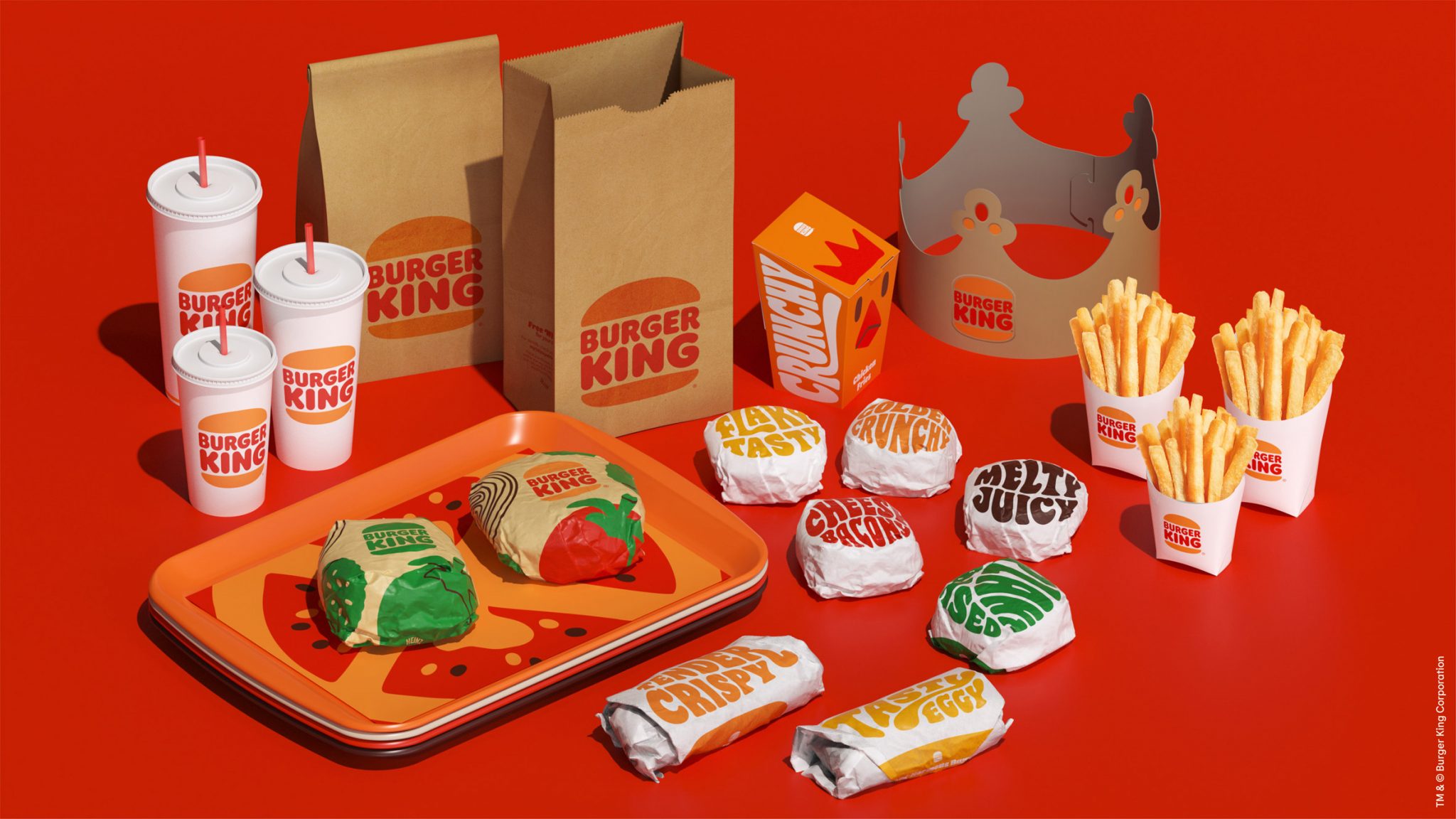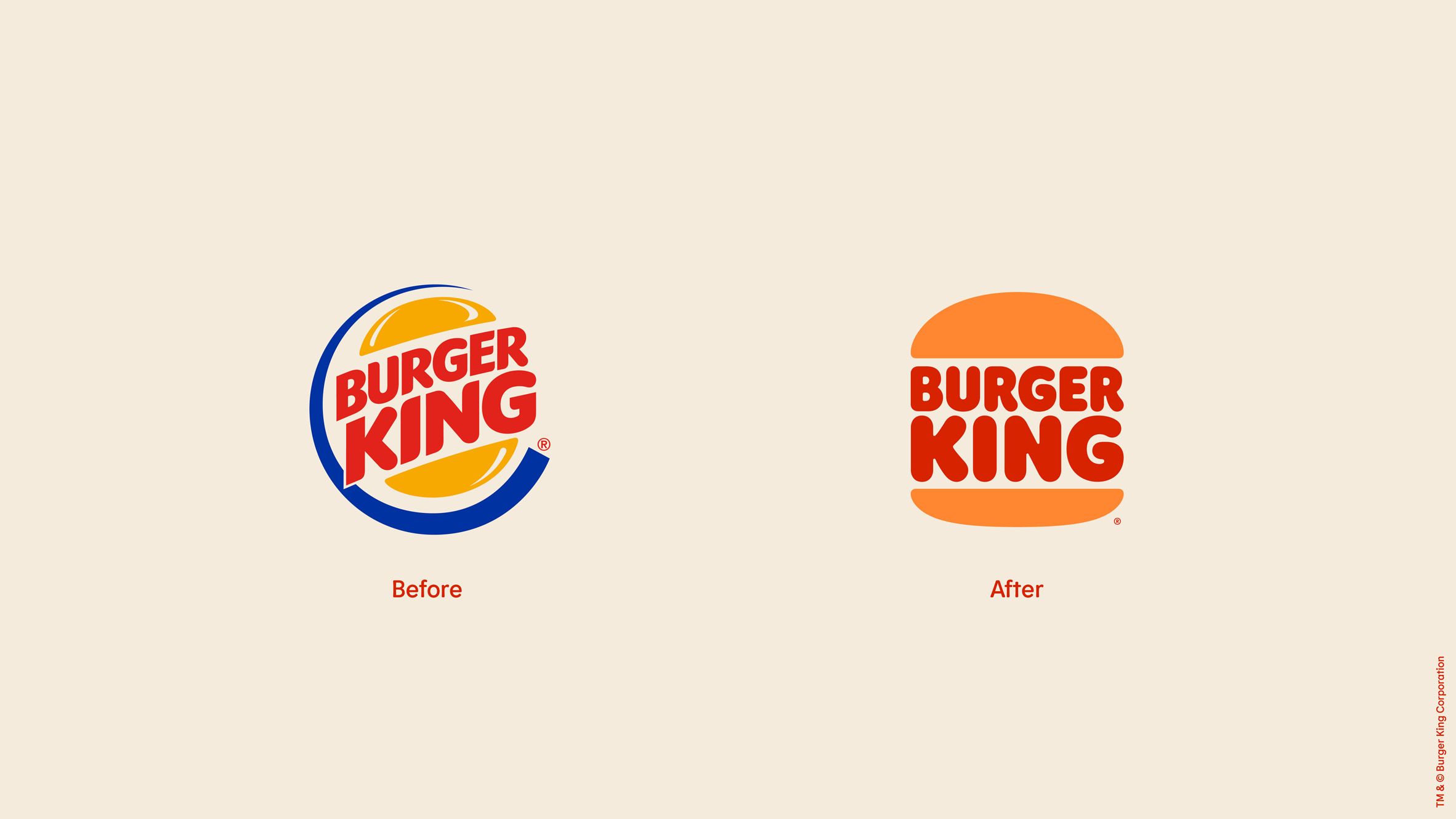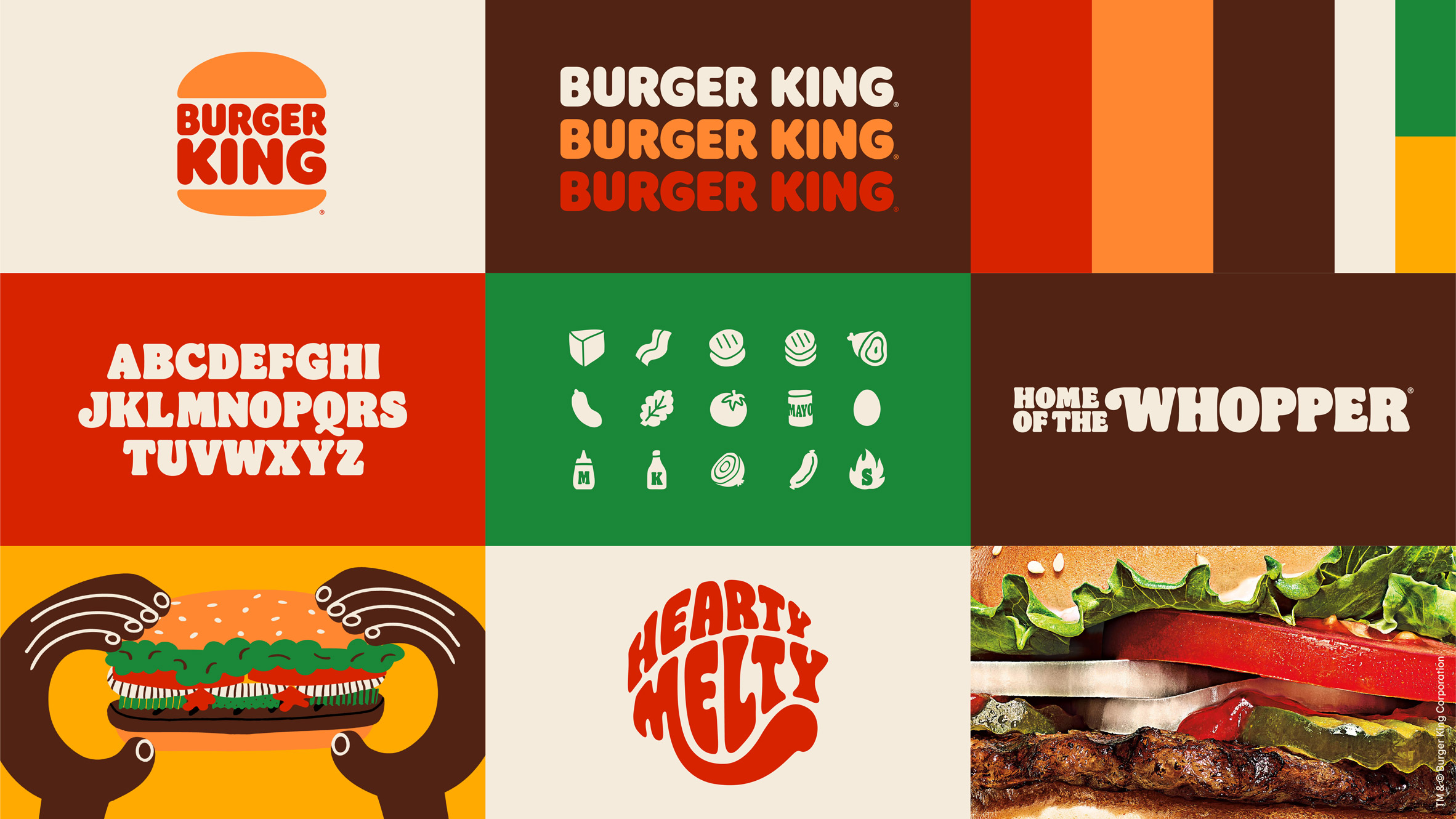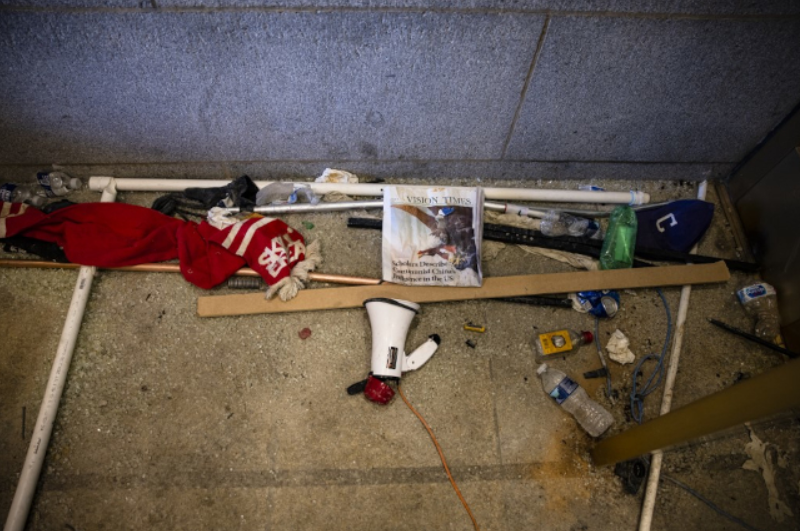Welcome to DU!
The truly grassroots left-of-center political community where regular people, not algorithms, drive the discussions and set the standards.
Join the community:
Create a free account
Support DU (and get rid of ads!):
Become a Star Member
Latest Breaking News
General Discussion
The DU Lounge
All Forums
Issue Forums
Culture Forums
Alliance Forums
Region Forums
Support Forums
Help & Search
Celerity
Celerity's Journal
Celerity's Journal
January 14, 2021

American fast-food restaurant Burger King has rebranded for the first time in 20 years with a revamped logo, packaging and uniforms designed by creative agency Jones Knowles Ritchie. Burger King has carried out a comprehensive rebrand to update all elements of its visual identity with a design that it describes as "mouthwatering, big and bold, playfully irreverent and proudly true". As part of this revamp the fast-food chain has ditched its previous logo, introduced in 1999, in favour of a flat design that is more aligned with the logo used by the brand throughout the 1970s, 80s and 90s.

The new logo replaces a design introduced in 1999
As with the pre-1999 designs, the simplified logo is more clearly two bun halves sandwiching the words Burger King. "We were inspired by the brand's original logo and how it has grown to have an iconic place in culture," explained Jones Knowles Ritchie. "The new logo pays homage to the brand's heritage with a refined design that's confident, simple and fun."

Alongside the new logo, Jones Knowles Ritchie has redesigned the brand's food packaging which will include the items' names written in a new custom typeface called Flame Sans. The overhaul includes redesigned uniforms for staff that will use a deep brown as their base colour. This will be paired with the new logo and trim in red, orange and white. Merchandising, menu boards, restaurant signage and marketing assets will also include the font and revised colour palette.


Burger King will start rolling out its rebrand immediately and is aiming to overhaul all of its restaurants over the next few years. The brand hopes that the redesign will help attract customers to its food. "Design is one of the most essential tools we have for communicating who we are and what we value, and it plays a vital role in creating desire for our food and maximizing guests’ experience," said Raphael Abreu, head of design at Restaurant Brands International, which owns the Burger King brand. "We wanted to use design to get people to crave our food; its flame-grilling perfection and above all, its taste."




Burger King reveals simplified logo as part of first rebrand in 20 years
https://www.dezeen.com/2021/01/09/burger-king-logo-rebrand-jones-knowles-ritchie/
American fast-food restaurant Burger King has rebranded for the first time in 20 years with a revamped logo, packaging and uniforms designed by creative agency Jones Knowles Ritchie. Burger King has carried out a comprehensive rebrand to update all elements of its visual identity with a design that it describes as "mouthwatering, big and bold, playfully irreverent and proudly true". As part of this revamp the fast-food chain has ditched its previous logo, introduced in 1999, in favour of a flat design that is more aligned with the logo used by the brand throughout the 1970s, 80s and 90s.

The new logo replaces a design introduced in 1999
As with the pre-1999 designs, the simplified logo is more clearly two bun halves sandwiching the words Burger King. "We were inspired by the brand's original logo and how it has grown to have an iconic place in culture," explained Jones Knowles Ritchie. "The new logo pays homage to the brand's heritage with a refined design that's confident, simple and fun."

Alongside the new logo, Jones Knowles Ritchie has redesigned the brand's food packaging which will include the items' names written in a new custom typeface called Flame Sans. The overhaul includes redesigned uniforms for staff that will use a deep brown as their base colour. This will be paired with the new logo and trim in red, orange and white. Merchandising, menu boards, restaurant signage and marketing assets will also include the font and revised colour palette.


Burger King will start rolling out its rebrand immediately and is aiming to overhaul all of its restaurants over the next few years. The brand hopes that the redesign will help attract customers to its food. "Design is one of the most essential tools we have for communicating who we are and what we value, and it plays a vital role in creating desire for our food and maximizing guests’ experience," said Raphael Abreu, head of design at Restaurant Brands International, which owns the Burger King brand. "We wanted to use design to get people to crave our food; its flame-grilling perfection and above all, its taste."




January 14, 2021

Three years ago, a town in northern Sweden handed out around 1,000 scarfs as Christmas gifts to former residents. Now, one of them has turned up in the violent attack on the US Capitol, and Swedes – and the Washington DC police – are trying to identify its wearer.
The mystery started when local residents in Skellefteå – a municipality of around 72,000 people almost 800 kilometres north of Stockholm – spotted the scarf on the floor in one of the many pictures showing the debris left by a violent mob of Trump supporters who stormed the US Capitol during a joint session of Congress. Skellefteå council officials confirmed to local newspaper Norran that it was one of around 1,000 scarfs they sent as Christmas gifts in 2017 to residents who had moved away from the area, an annual tradition. "We've been doing it for at least five years. The gifts have varied, one year we sent out Pride mittens," Skellefteå marketing director Helena Renström told Norran.
Swedish national daily Dagens Nyheter (DN) then managed to track down several pictures of a man wearing the scarf while taking part in the riot. He can be seen waving an American flag outside the Capitol, pushing against the police fences, as well as inside the building discussing the floor plan with other people, among other places. The man had as of noon on Thursday not been identified – and it is not known whether he is a Swedish national or not. DN has gone through a list of the 934 people who received the red scarfs in 2017. Out of those, only one lives in the US, a woman. She told DN that she received socks, not a scarf, and did not recognise the man.
https://twitter.com/cm_merlin/status/1349252219242237952
https://twitter.com/pwolodarski/status/1349013410017644544
The man has also been identified as a "person of interest in unrest-related offenses" by the Metropolitan Police in Washington DC, who are appealing for more information. Meanwhile, he has been dubbed "the Skellefteå man" in some of Sweden's biggest newspapers, who are racing to unpick the mystery of the red scarf. "You really want to know how the scarf made it to the US and how the man got hold of it. Nobody would have thought that such a small town in northern Sweden would play such a big part in such a mockery of democracy," Skellefteå resident Johanna-Lovisa Vannebäck, the first person who spotted the scarf, told Aftonbladet.
snip
Who's the man in the red scarf at the US Capitol? Sweden wants to know
https://www.thelocal.se/20210114/whos-the-man-in-the-red-scarf-at-the-us-capitol-sweden-wants-to-know
Three years ago, a town in northern Sweden handed out around 1,000 scarfs as Christmas gifts to former residents. Now, one of them has turned up in the violent attack on the US Capitol, and Swedes – and the Washington DC police – are trying to identify its wearer.
The mystery started when local residents in Skellefteå – a municipality of around 72,000 people almost 800 kilometres north of Stockholm – spotted the scarf on the floor in one of the many pictures showing the debris left by a violent mob of Trump supporters who stormed the US Capitol during a joint session of Congress. Skellefteå council officials confirmed to local newspaper Norran that it was one of around 1,000 scarfs they sent as Christmas gifts in 2017 to residents who had moved away from the area, an annual tradition. "We've been doing it for at least five years. The gifts have varied, one year we sent out Pride mittens," Skellefteå marketing director Helena Renström told Norran.
Swedish national daily Dagens Nyheter (DN) then managed to track down several pictures of a man wearing the scarf while taking part in the riot. He can be seen waving an American flag outside the Capitol, pushing against the police fences, as well as inside the building discussing the floor plan with other people, among other places. The man had as of noon on Thursday not been identified – and it is not known whether he is a Swedish national or not. DN has gone through a list of the 934 people who received the red scarfs in 2017. Out of those, only one lives in the US, a woman. She told DN that she received socks, not a scarf, and did not recognise the man.
https://twitter.com/cm_merlin/status/1349252219242237952
https://twitter.com/pwolodarski/status/1349013410017644544
The man has also been identified as a "person of interest in unrest-related offenses" by the Metropolitan Police in Washington DC, who are appealing for more information. Meanwhile, he has been dubbed "the Skellefteå man" in some of Sweden's biggest newspapers, who are racing to unpick the mystery of the red scarf. "You really want to know how the scarf made it to the US and how the man got hold of it. Nobody would have thought that such a small town in northern Sweden would play such a big part in such a mockery of democracy," Skellefteå resident Johanna-Lovisa Vannebäck, the first person who spotted the scarf, told Aftonbladet.
snip
January 14, 2021
https://www.newstatesman.com/politics/staggers/2021/01/richard-leonard-s-resignation-alone-won-t-end-scottish-labour-s-woes
In the end, Richard Leonard has bowed to the crushing inevitability of political logic. His resignation as leader of Scottish Labour comes after three disastrous years at the helm – yet the biggest disaster of all was months away. The party goes into May’s Holyrood election in terrible shape. And it is an election that matters more than most, as a majority for the SNP would give it a mandate for a second independence referendum. Labour, which had once been the Union’s bulwark in Scotland, now barely registers. Its repeated, confused shifting of position on whether to support a referendum has allowed the Tories to become the nation’s main Unionist force, and also to push Labour into third place at the Scottish parliament, while the SNP has stolen its clothes on the centre left.
Leonard himself was entirely the wrong man for the job – an old socialist, he surfed the Corbynite wave to power, but lacked the politics and the personality to grab voters’ attention. Neither was there any Momentum-style structure north of the border to support his brand of politics, to develop policy, or to suggest he was anything other than the figurehead of a small and tightly-knit gang of unreconstructed leftists. Scotland is not the left-wing country the idealists like to claim. Leonard’s political offer, based on a romanticised vision of the working class and a fiery statist commitment to workers’ rights, was old-fashioned and said nothing to Middle Scotland about its priorities. His strange, bobbing appearances at First Minister’s Questions were always a bit sub-Scargill. He shouted too much – “someone tell Richard there’s a microphone”, was one opponent’s response.
Last year the centre left attempted to remove him from power, after a dismal run of election results. Scottish Labour lost both its MEPs in the 2019 EU elections, and all but one of its MPs in the same year’s general election. Leonard survived, but only just – there was no great enthusiasm for him even among those who remained loyal. The election of Jackie Baillie as deputy leader last year indicated his time was drawing to a close. Bailie, an experienced and well-liked former minister and shadow cabinet member, was an open critic of Leonard’s. The party had decided it was time to move on. The election of Keir Starmer as UK Labour leader only emphasised the point.
snip
His successor is likely to come from the moderate wing of the party – someone more in sympathy with Starmer’s approach. Baillie is an obvious contender, as is Monica Lennon, who mounted a successful cross-party campaign to end period poverty. Anas Sarwar, the party’s spokesman on Brexit and the constitution, is also expected to throw his hat into the ring. But as the saying has it, you wouldn’t start from here. The next leader will have only a few months to connect with voters and design a manifesto that has broad appeal. Meanwhile, the Scottish party structure is hollowed out and many of Labour’s MSPs have been at Holyrood for too long. Scottish Labour can still expect a hefty beating in May’s election, but at least now the work of renewal can begin. The question is whether it’s all too late.
snip
Richard Leonard's resignation alone won't end Scottish Labour's woes
Nicola Sturgeon’s SNP long ago supplanted Labour as the party of choice for most Scottish socialists.https://www.newstatesman.com/politics/staggers/2021/01/richard-leonard-s-resignation-alone-won-t-end-scottish-labour-s-woes
In the end, Richard Leonard has bowed to the crushing inevitability of political logic. His resignation as leader of Scottish Labour comes after three disastrous years at the helm – yet the biggest disaster of all was months away. The party goes into May’s Holyrood election in terrible shape. And it is an election that matters more than most, as a majority for the SNP would give it a mandate for a second independence referendum. Labour, which had once been the Union’s bulwark in Scotland, now barely registers. Its repeated, confused shifting of position on whether to support a referendum has allowed the Tories to become the nation’s main Unionist force, and also to push Labour into third place at the Scottish parliament, while the SNP has stolen its clothes on the centre left.
Leonard himself was entirely the wrong man for the job – an old socialist, he surfed the Corbynite wave to power, but lacked the politics and the personality to grab voters’ attention. Neither was there any Momentum-style structure north of the border to support his brand of politics, to develop policy, or to suggest he was anything other than the figurehead of a small and tightly-knit gang of unreconstructed leftists. Scotland is not the left-wing country the idealists like to claim. Leonard’s political offer, based on a romanticised vision of the working class and a fiery statist commitment to workers’ rights, was old-fashioned and said nothing to Middle Scotland about its priorities. His strange, bobbing appearances at First Minister’s Questions were always a bit sub-Scargill. He shouted too much – “someone tell Richard there’s a microphone”, was one opponent’s response.
Last year the centre left attempted to remove him from power, after a dismal run of election results. Scottish Labour lost both its MEPs in the 2019 EU elections, and all but one of its MPs in the same year’s general election. Leonard survived, but only just – there was no great enthusiasm for him even among those who remained loyal. The election of Jackie Baillie as deputy leader last year indicated his time was drawing to a close. Bailie, an experienced and well-liked former minister and shadow cabinet member, was an open critic of Leonard’s. The party had decided it was time to move on. The election of Keir Starmer as UK Labour leader only emphasised the point.
snip
His successor is likely to come from the moderate wing of the party – someone more in sympathy with Starmer’s approach. Baillie is an obvious contender, as is Monica Lennon, who mounted a successful cross-party campaign to end period poverty. Anas Sarwar, the party’s spokesman on Brexit and the constitution, is also expected to throw his hat into the ring. But as the saying has it, you wouldn’t start from here. The next leader will have only a few months to connect with voters and design a manifesto that has broad appeal. Meanwhile, the Scottish party structure is hollowed out and many of Labour’s MSPs have been at Holyrood for too long. Scottish Labour can still expect a hefty beating in May’s election, but at least now the work of renewal can begin. The question is whether it’s all too late.
snip
January 14, 2021
What happens after the Capitol attacks? Alexandria Ocasio-Cortez
1 hour of shredding the fucking Q-MAGAts ![]()
January 14, 2021
https://coloradotimesrecorder.com/2020/08/arrest-warrants-issued-for-boebert/29118/
Lauren Boebert Full Rapsheet
https://static1.squarespace.com/static/5f4b155ca23dbb3ab868b37d/t/5f7527900df493541c537a83/1601513362385/LB+Rapsheet+Full.pdf


Arrest Warrants Issued for Boebert in Multiple Cases After She Didn't Show Up for Court Hearings
When arrested in 2015 for disorderly conduct, Boebert warned deputies at the time that she had “friends at Fox News.”https://coloradotimesrecorder.com/2020/08/arrest-warrants-issued-for-boebert/29118/
Lauren Boebert Full Rapsheet
https://static1.squarespace.com/static/5f4b155ca23dbb3ab868b37d/t/5f7527900df493541c537a83/1601513362385/LB+Rapsheet+Full.pdf


January 14, 2021
https://www.socialeurope.eu/whither-america
The assault on the US Capitol by supporters of the president, Donald Trump, incited by Trump himself, was the predictable outcome of his four-year assault on democratic institutions, aided and abetted by so many in the Republican Party. And no one can say that Trump had not warned us: he was not committed to a peaceful transition of power. Many who benefited as he slashed taxes for corporations and the rich, rolled back environmental regulations and appointed business-friendly judges knew they were making a pact with the devil. Either they believed they could control the extremist forces he unleashed, or they didn’t care. Where does America go from here? Is Trump an aberration or a symptom of a deeper national malady? Can the United States be trusted? In four years, will the forces that gave rise to Trump, and the party that overwhelmingly supported him, triumph again? What can be done to prevent that outcome?
Multiple forces
Trump is the product of multiple forces. For at least a quarter-century, the Republican Party has understood that it could represent the interests of business elites only by embracing anti-democratic measures (including voter suppression and gerrymandering) and allies, including the religious fundamentalists, white supremacists and nationalist populists. Of course, populism implied policies that were antithetical to business elites. But many business leaders spent decades mastering the ability to deceive the public. Big Tobacco spent lavishly on lawyers and bogus science to deny their products’ adverse health effects. Big Oil did likewise to deny fossil fuels’ contribution to climate change. They recognised that Trump was one of their own. Then advances in technology provided a tool for rapid dissemination of misinformation and America’s political system, where money reigns supreme, allowed the emerging tech giants freedom from accountability. This political system did one other thing: it generated a set of policies (sometimes referred to as neoliberalism) that delivered massive income and wealth gains to those at the top but near-stagnation everywhere elsewhere. Soon a country on the cutting edge of scientific progress was marked by declining life expectancy and increasing health disparities.
Fundamentally spurious
The neoliberal promise that wealth and income gains would trickle down to those at the bottom was fundamentally spurious. As massive structural changes deindustrialised large parts of the country, those left behind were left to fend largely for themselves. As I warned in my books The Price of Inequality and People, Power, and Profits, this toxic mix provided an inviting opportunity for a would-be demagogue. As we have repeatedly seen, Americans’ entrepreneurial spirit, combined with an absence of moral constraints, provides an ample supply of charlatans, exploiters, and would-be demagogues. Trump, a mendacious, narcissistic sociopath, with no understanding of economics or appreciation of democracy, was the man of the moment. The immediate task is to remove the threat Trump still poses. The House of Representatives should impeach him now and the Senate should try him some time later, to bar him from holding federal office again. It should be in the interest of the Republicans, no less than the Democrats, to show that no one, not even the president, is above the law. Everyone must understand the imperative of honouring elections and ensuring the peaceful transition of power.
Underlying problems
But we should not sleep comfortably until the underlying problems are addressed. Many involve great challenges. We must reconcile freedom of expression with accountability for the enormous harm that ‘social media’ can and has caused, from inciting violence and promoting racial and religious hatred to political manipulation. The US and other countries have long imposed restrictions on other forms of expression to reflect broader societal concerns: one may not shout fire in a crowded theatre, engage in child pornography or commit slander and libel. True, some authoritarian regimes abuse these constraints and compromise basic freedoms, but authoritarian regimes will always find justifications for doing what they will, regardless of what democratic governments do. We Americans must reform our political system, to ensure both the basic right to vote and democratic representation. We need a new voting rights act. The old one, adopted in 1965, was aimed at the south, where disenfranchisement of African-Americans had enabled white elites to remain in power since the end of reconstruction following the civil war. But now anti-democratic practices are found throughout the country. We also need to decrease the influence of money in our politics: no system of checks and balances can be effective in a society with as much inequality as the US. And any system based on ‘one dollar, one vote’ rather than ‘one person, one vote’ will be vulnerable to populist demagogy. After all, how can such a system serve the interests of the country as a whole?
Striking difference........
Joseph Stiglitz : Whither America?
It will take more than one person—and more than one presidential term—to overcome America’s longstanding challenges.https://www.socialeurope.eu/whither-america
The assault on the US Capitol by supporters of the president, Donald Trump, incited by Trump himself, was the predictable outcome of his four-year assault on democratic institutions, aided and abetted by so many in the Republican Party. And no one can say that Trump had not warned us: he was not committed to a peaceful transition of power. Many who benefited as he slashed taxes for corporations and the rich, rolled back environmental regulations and appointed business-friendly judges knew they were making a pact with the devil. Either they believed they could control the extremist forces he unleashed, or they didn’t care. Where does America go from here? Is Trump an aberration or a symptom of a deeper national malady? Can the United States be trusted? In four years, will the forces that gave rise to Trump, and the party that overwhelmingly supported him, triumph again? What can be done to prevent that outcome?
Multiple forces
Trump is the product of multiple forces. For at least a quarter-century, the Republican Party has understood that it could represent the interests of business elites only by embracing anti-democratic measures (including voter suppression and gerrymandering) and allies, including the religious fundamentalists, white supremacists and nationalist populists. Of course, populism implied policies that were antithetical to business elites. But many business leaders spent decades mastering the ability to deceive the public. Big Tobacco spent lavishly on lawyers and bogus science to deny their products’ adverse health effects. Big Oil did likewise to deny fossil fuels’ contribution to climate change. They recognised that Trump was one of their own. Then advances in technology provided a tool for rapid dissemination of misinformation and America’s political system, where money reigns supreme, allowed the emerging tech giants freedom from accountability. This political system did one other thing: it generated a set of policies (sometimes referred to as neoliberalism) that delivered massive income and wealth gains to those at the top but near-stagnation everywhere elsewhere. Soon a country on the cutting edge of scientific progress was marked by declining life expectancy and increasing health disparities.
Fundamentally spurious
The neoliberal promise that wealth and income gains would trickle down to those at the bottom was fundamentally spurious. As massive structural changes deindustrialised large parts of the country, those left behind were left to fend largely for themselves. As I warned in my books The Price of Inequality and People, Power, and Profits, this toxic mix provided an inviting opportunity for a would-be demagogue. As we have repeatedly seen, Americans’ entrepreneurial spirit, combined with an absence of moral constraints, provides an ample supply of charlatans, exploiters, and would-be demagogues. Trump, a mendacious, narcissistic sociopath, with no understanding of economics or appreciation of democracy, was the man of the moment. The immediate task is to remove the threat Trump still poses. The House of Representatives should impeach him now and the Senate should try him some time later, to bar him from holding federal office again. It should be in the interest of the Republicans, no less than the Democrats, to show that no one, not even the president, is above the law. Everyone must understand the imperative of honouring elections and ensuring the peaceful transition of power.
Underlying problems
But we should not sleep comfortably until the underlying problems are addressed. Many involve great challenges. We must reconcile freedom of expression with accountability for the enormous harm that ‘social media’ can and has caused, from inciting violence and promoting racial and religious hatred to political manipulation. The US and other countries have long imposed restrictions on other forms of expression to reflect broader societal concerns: one may not shout fire in a crowded theatre, engage in child pornography or commit slander and libel. True, some authoritarian regimes abuse these constraints and compromise basic freedoms, but authoritarian regimes will always find justifications for doing what they will, regardless of what democratic governments do. We Americans must reform our political system, to ensure both the basic right to vote and democratic representation. We need a new voting rights act. The old one, adopted in 1965, was aimed at the south, where disenfranchisement of African-Americans had enabled white elites to remain in power since the end of reconstruction following the civil war. But now anti-democratic practices are found throughout the country. We also need to decrease the influence of money in our politics: no system of checks and balances can be effective in a society with as much inequality as the US. And any system based on ‘one dollar, one vote’ rather than ‘one person, one vote’ will be vulnerable to populist demagogy. After all, how can such a system serve the interests of the country as a whole?
Striking difference........
January 14, 2021
https://www.theatlantic.com/culture/archive/2021/01/2021-movie-preview/617567/

Curating a film preview for 2021 involves all the necessary caveats. Because the cinema industry remains deeply in flux and many theaters have yet to reopen, this year will likely be full of schedule changes and surprise decisions to move some projects to streaming. One major studio, Warner Bros., plans to debut each of its films simultaneously in theaters and on the streaming service HBO Max; others, like Disney, will offer some titles online for a premium price. What stands out about the 2021 movie landscape is how much the lineup resembles that of 2020: Almost every big studio project from then has been punted here, as distributors hope for a redo after a lost year. Whether they’ll get their wish is a colossal question.

THE LITTLE THINGS (JANUARY 29)
The rollout of Wonder Woman 1984 last month was a preview for an entire year of Warner Bros. films that will arrive simultaneously on HBO Max and in theaters. While the glitz of a superhero movie was enough to pull record viewership numbers, will a more workmanlike crime drama make as big of a wave for the studio? Warner Bros.’s The Little Things, about a dogged county sheriff trying to crack a serial-killer case, has a hefty cast with Denzel Washington, Jared Leto, and Rami Malek (all Oscar winners). It could be a solid late-January distraction if nothing else.

CRUELLA (MAY 28)
Another in a long line of Disney remakes of its animated classics, this film is taking the same path as Maleficent by foregrounding its villain and deepening her past. Emma Stone is taking up the mantle of One Hundred and One Dalmatians antagonist Cruella de Vil, the fur-obsessed puppy murderer, and the film has a 1970s setting as it explores her younger days. Do we really need to find out why Cruella got so obsessed with Dalmatians? I, Tonya director Craig Gillespie seems to think so, and he has Emma Thompson and Paul Walter Hauser rounding out the cast.
THE TOMORROW WAR (JULY 23)
An original sci-fi action movie is a rarity these days, which makes The Tomorrow War an exciting prospect. Produced by and starring Chris Pratt, this alien-invasion film sees humanity developing technology to “draft” soldiers from the past to help fight a war. Soldiers out of time could mean a comedy element, as suggested by much of the movie’s cast (Betty Gilpin, Sam Richardson, Mike Mitchell, Mary Lynn Rajskub) and its director, Chris McKay, who in 2017 worked wonders with the bizarre premise of a Lego Batman movie.
THE MATRIX 4 (DECEMBER 22)
Everything old in Hollywood is new again, and now that time has come for The Matrix, which helped change the industry when it debuted in 1999. Written and directed by Lana Wachowski (half of the sister duo who created the original Matrix trilogy), this entry is a mystery for now; all that’s known is that former stars Keanu Reeves, Carrie-Anne Moss, and Jada Pinkett Smith will be involved, along with Yahya Abdul-Mateen II and Neil Patrick Harris. There’s no better time than 2021 to rewatch the entire series, including The Matrix’s brilliant and unfairly maligned sequels, and get ready for whatever spectacular strangeness Wachowski has planned this time
snip
25 Movies to Look Forward to in 2021
Thanks to the pandemic, this list is more familiar and tentative than most annual film previews.https://www.theatlantic.com/culture/archive/2021/01/2021-movie-preview/617567/

Curating a film preview for 2021 involves all the necessary caveats. Because the cinema industry remains deeply in flux and many theaters have yet to reopen, this year will likely be full of schedule changes and surprise decisions to move some projects to streaming. One major studio, Warner Bros., plans to debut each of its films simultaneously in theaters and on the streaming service HBO Max; others, like Disney, will offer some titles online for a premium price. What stands out about the 2021 movie landscape is how much the lineup resembles that of 2020: Almost every big studio project from then has been punted here, as distributors hope for a redo after a lost year. Whether they’ll get their wish is a colossal question.

THE LITTLE THINGS (JANUARY 29)
The rollout of Wonder Woman 1984 last month was a preview for an entire year of Warner Bros. films that will arrive simultaneously on HBO Max and in theaters. While the glitz of a superhero movie was enough to pull record viewership numbers, will a more workmanlike crime drama make as big of a wave for the studio? Warner Bros.’s The Little Things, about a dogged county sheriff trying to crack a serial-killer case, has a hefty cast with Denzel Washington, Jared Leto, and Rami Malek (all Oscar winners). It could be a solid late-January distraction if nothing else.

CRUELLA (MAY 28)
Another in a long line of Disney remakes of its animated classics, this film is taking the same path as Maleficent by foregrounding its villain and deepening her past. Emma Stone is taking up the mantle of One Hundred and One Dalmatians antagonist Cruella de Vil, the fur-obsessed puppy murderer, and the film has a 1970s setting as it explores her younger days. Do we really need to find out why Cruella got so obsessed with Dalmatians? I, Tonya director Craig Gillespie seems to think so, and he has Emma Thompson and Paul Walter Hauser rounding out the cast.
THE TOMORROW WAR (JULY 23)
An original sci-fi action movie is a rarity these days, which makes The Tomorrow War an exciting prospect. Produced by and starring Chris Pratt, this alien-invasion film sees humanity developing technology to “draft” soldiers from the past to help fight a war. Soldiers out of time could mean a comedy element, as suggested by much of the movie’s cast (Betty Gilpin, Sam Richardson, Mike Mitchell, Mary Lynn Rajskub) and its director, Chris McKay, who in 2017 worked wonders with the bizarre premise of a Lego Batman movie.
THE MATRIX 4 (DECEMBER 22)
Everything old in Hollywood is new again, and now that time has come for The Matrix, which helped change the industry when it debuted in 1999. Written and directed by Lana Wachowski (half of the sister duo who created the original Matrix trilogy), this entry is a mystery for now; all that’s known is that former stars Keanu Reeves, Carrie-Anne Moss, and Jada Pinkett Smith will be involved, along with Yahya Abdul-Mateen II and Neil Patrick Harris. There’s no better time than 2021 to rewatch the entire series, including The Matrix’s brilliant and unfairly maligned sequels, and get ready for whatever spectacular strangeness Wachowski has planned this time
snip
January 14, 2021
https://www.theatlantic.com/health/archive/2021/01/why-arent-we-wearing-better-masks/617656/

If you’re like most Americans, there’s a good chance you’re going to wear a cloth mask today. Doing so makes sense. It remains the official recommendation in the United States, and it is something we’ve both advocated since the beginning of the pandemic. Both of us wrote articles as far back as March urging people to wear homemade cloth masks. We’re also the authors (along with 17 other experts) of a paper titled “An Evidence Review of Face Masks Against COVID,” which was just published in peer-reviewed form in the Proceedings of the National Academy of Sciences. But it’s past time for better solutions to be available to the public. We first released the paper as a preprint back in April, and it took nine months to go through peer review. We’re happy that it’s published but, to be honest, we’re also deeply disappointed that it’s still relevant. We’d hoped that by 2021 supply chains would have ramped up enough to ensure that everyone had better masks. Cloth masks, especially homemade ones, were supposed to be a stopgap measure. Why are so many of us still wearing them?
Don’t get us wrong; everything we said about the efficacy of cloth masks stands the test of time. Wearing them is much better than wearing nothing. They definitely help reduce transmission of the coronavirus from the wearer and likely protect the wearer to some degree as well. But we know that not all masks are equal, and early on in the pandemic, there was a dire shortage of higher-grade masks for medical workers. During those emergency conditions, something was much better than nothing. There are better possibilities now, but they require action and guidance by the authorities. Even all cloth masks are not equal. Construction, materials, and fit matter, and these can’t be tracked or certified with homemade masks. Unlike cloth masks, medical-grade masks (also called respirators) that adhere to standards such as N95 (in the U.S.), FFP2 (in the European Union), and KN95 (in China) do a much better job of protecting the wearer and dampening transmission. Ideally, they should also come with instructions on how to wear them and ensure that they fit properly.
Because we have written about masks, we’ve become informal advisers to friends, family, and strangers on the internet. We’re not much help, though. When our friends ask us simple questions like “Where should I buy a mask?” or “Is my mask any good?,” we don’t have great answers. We can mumble generalities: Make sure it fits well; here are some guidelines about layers; try to avoid fake N95s. But if we can’t give wholly satisfying answers to such basic questions, then how is the general public expected to fare. Tragically, America is swamped with fraudulent medical-grade masks, some of which are only 1 percent effective. Many masks do not have labels clearly indicating their manufacturer. Some official mask-testing methods are inappropriate, including the use of far higher pressure than normal breathing exerts. No reasonable certification is available for the most useful masks generally available to the public. All of this means that everyone has to somehow figure out for themselves which masks are effective.
We routinely get PR pitches for excellent new solutions as well as snake-oil remedies, and we sometimes have trouble telling them apart—how is an ordinary person supposed to evaluate competing claims? When we share our articles about masks on social media, we are asked where to buy proper masks. Not only do we have no answer, but we often find that marketers will answer instead, directing readers to unreliable, overpriced masks. Worse, the supply situation apparently remains so dire that the CDC still “does not recommend that the general public wear N95 respirators,” because they’re crucial supplies that must continue to be reserved for health-care workers and other first responders. Not all countries have this problem. Taiwan massively scaled up its manufacturing of masks at the start of 2020, such that by April every citizen received a fresh supply of high-quality masks each week, and the distribution system was regulated by the government. Taiwan’s COVID-19 death rate per capita is more than 1,000 times lower than that in the U.S. Hong Kong has been distributing patented six-layer masks (the efficacy of which has been laboratory tested) to every citizen. Singapore is on at least its fourth round of distributing free, reusable, multilayer masks with filters to everyone—even kids, who get kid-size ones. In Germany, Bavaria has just announced that it will be requiring higher-grade masks. If all of these places can do this, why can’t we?
snip
https://twitter.com/AbraarKaran/status/1348641693885726720
https://twitter.com/kniggem/status/1348994519811895299
Why Aren't We Wearing Better Masks?
Cloth masks are better than nothing, but they were supposed to be a stopgap measure.https://www.theatlantic.com/health/archive/2021/01/why-arent-we-wearing-better-masks/617656/

If you’re like most Americans, there’s a good chance you’re going to wear a cloth mask today. Doing so makes sense. It remains the official recommendation in the United States, and it is something we’ve both advocated since the beginning of the pandemic. Both of us wrote articles as far back as March urging people to wear homemade cloth masks. We’re also the authors (along with 17 other experts) of a paper titled “An Evidence Review of Face Masks Against COVID,” which was just published in peer-reviewed form in the Proceedings of the National Academy of Sciences. But it’s past time for better solutions to be available to the public. We first released the paper as a preprint back in April, and it took nine months to go through peer review. We’re happy that it’s published but, to be honest, we’re also deeply disappointed that it’s still relevant. We’d hoped that by 2021 supply chains would have ramped up enough to ensure that everyone had better masks. Cloth masks, especially homemade ones, were supposed to be a stopgap measure. Why are so many of us still wearing them?
Don’t get us wrong; everything we said about the efficacy of cloth masks stands the test of time. Wearing them is much better than wearing nothing. They definitely help reduce transmission of the coronavirus from the wearer and likely protect the wearer to some degree as well. But we know that not all masks are equal, and early on in the pandemic, there was a dire shortage of higher-grade masks for medical workers. During those emergency conditions, something was much better than nothing. There are better possibilities now, but they require action and guidance by the authorities. Even all cloth masks are not equal. Construction, materials, and fit matter, and these can’t be tracked or certified with homemade masks. Unlike cloth masks, medical-grade masks (also called respirators) that adhere to standards such as N95 (in the U.S.), FFP2 (in the European Union), and KN95 (in China) do a much better job of protecting the wearer and dampening transmission. Ideally, they should also come with instructions on how to wear them and ensure that they fit properly.
Because we have written about masks, we’ve become informal advisers to friends, family, and strangers on the internet. We’re not much help, though. When our friends ask us simple questions like “Where should I buy a mask?” or “Is my mask any good?,” we don’t have great answers. We can mumble generalities: Make sure it fits well; here are some guidelines about layers; try to avoid fake N95s. But if we can’t give wholly satisfying answers to such basic questions, then how is the general public expected to fare. Tragically, America is swamped with fraudulent medical-grade masks, some of which are only 1 percent effective. Many masks do not have labels clearly indicating their manufacturer. Some official mask-testing methods are inappropriate, including the use of far higher pressure than normal breathing exerts. No reasonable certification is available for the most useful masks generally available to the public. All of this means that everyone has to somehow figure out for themselves which masks are effective.
We routinely get PR pitches for excellent new solutions as well as snake-oil remedies, and we sometimes have trouble telling them apart—how is an ordinary person supposed to evaluate competing claims? When we share our articles about masks on social media, we are asked where to buy proper masks. Not only do we have no answer, but we often find that marketers will answer instead, directing readers to unreliable, overpriced masks. Worse, the supply situation apparently remains so dire that the CDC still “does not recommend that the general public wear N95 respirators,” because they’re crucial supplies that must continue to be reserved for health-care workers and other first responders. Not all countries have this problem. Taiwan massively scaled up its manufacturing of masks at the start of 2020, such that by April every citizen received a fresh supply of high-quality masks each week, and the distribution system was regulated by the government. Taiwan’s COVID-19 death rate per capita is more than 1,000 times lower than that in the U.S. Hong Kong has been distributing patented six-layer masks (the efficacy of which has been laboratory tested) to every citizen. Singapore is on at least its fourth round of distributing free, reusable, multilayer masks with filters to everyone—even kids, who get kid-size ones. In Germany, Bavaria has just announced that it will be requiring higher-grade masks. If all of these places can do this, why can’t we?
snip
https://twitter.com/AbraarKaran/status/1348641693885726720
https://twitter.com/kniggem/status/1348994519811895299
January 13, 2021

President-elect Joe Biden is set to restore a bipartisan norm upon moving into the White House: presidential dogs. The Bidens have two German shepherds, Champ and Major. Major, in particular, has a "wags to riches" tail. He'll soon be the first dog to go from a shelter to the White House. That shelter, the Delaware Humane Association, plans to "indogurate" Major on Sunday in a virtual ceremony. (People and pets alike are invited to attend.)
In early 2018, the shelter received a litter of six German shepherd puppies, including the future first dog. The puppies were in a medical crisis.

President-elect Joe Biden began fostering Major, top, shortly after the dog arrived at the Delaware Humane Association in March 2018. Stephanie Gomez Carter/Delaware Humane Association
"They were very sick," said Patrick Carroll, executive director of the Delaware Humane Association. "They had gotten into a toxic substance. We're not sure what. "The dogs were lethargic, vomiting and hospitalized for a few days," Carroll says. The pups bounced back. They recovered with fluids and medication. The shelter posted to Facebook in March 2018 in search of foster homes. According to Carroll, Ashley Biden sent the post to her father, knowing he was looking for a companion for the aging Champ.
Joe Biden showed up. "He just dropped in on Easter Sunday of all days," Carroll said, "and wanted to meet the puppies." Soon, Major was in foster with the Bidens. Within months, the news broke that he had found his forever (fur-ever?) home. Biden returned to the shelter with a grown Major to officially adopt him in November 2018.
snip
https://twitter.com/CBSSunday/status/1332512786732244993
Biden's German Shepherd To Be Celebrated With 'Indoguration' Hosted By Animal Shelter
https://www.npr.org/2021/01/13/956096928/bidens-german-shepherd-to-be-celebrated-with-indoguration-hosted-by-animal-shelt
President-elect Joe Biden is set to restore a bipartisan norm upon moving into the White House: presidential dogs. The Bidens have two German shepherds, Champ and Major. Major, in particular, has a "wags to riches" tail. He'll soon be the first dog to go from a shelter to the White House. That shelter, the Delaware Humane Association, plans to "indogurate" Major on Sunday in a virtual ceremony. (People and pets alike are invited to attend.)
In early 2018, the shelter received a litter of six German shepherd puppies, including the future first dog. The puppies were in a medical crisis.

President-elect Joe Biden began fostering Major, top, shortly after the dog arrived at the Delaware Humane Association in March 2018. Stephanie Gomez Carter/Delaware Humane Association
"They were very sick," said Patrick Carroll, executive director of the Delaware Humane Association. "They had gotten into a toxic substance. We're not sure what. "The dogs were lethargic, vomiting and hospitalized for a few days," Carroll says. The pups bounced back. They recovered with fluids and medication. The shelter posted to Facebook in March 2018 in search of foster homes. According to Carroll, Ashley Biden sent the post to her father, knowing he was looking for a companion for the aging Champ.
Joe Biden showed up. "He just dropped in on Easter Sunday of all days," Carroll said, "and wanted to meet the puppies." Soon, Major was in foster with the Bidens. Within months, the news broke that he had found his forever (fur-ever?) home. Biden returned to the shelter with a grown Major to officially adopt him in November 2018.
snip
https://twitter.com/CBSSunday/status/1332512786732244993
Profile Information
Gender: FemaleHometown: London
Home country: US/UK/Sweden
Current location: Stockholm, Sweden
Member since: Sun Jul 1, 2018, 07:25 PM
Number of posts: 43,343